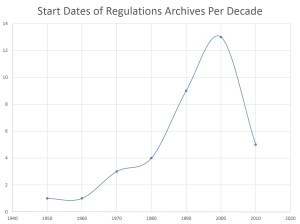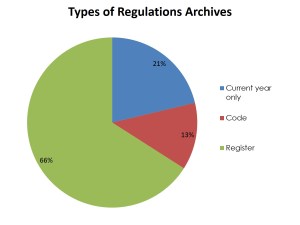A quirk of legal research is that one never quite knows how much content is enough for their research needs. A case from the 1700s could still be good law, and a regulation from the 1970s may be the one binding in a particular case. It should be noted, however, that in The Citation and Depreciation of U.S. Supreme Court Precedent, 10 J. Empirical Legal Stud. 325, the authors showed that a US Supreme Court depreciates in citation value after about 20 years. So it could be argued that a complete collection of case law, at least, is not absolutely mandatory in order to do adequate legal research.
This study found that incomplete collections of codes, regulations and case law were the norm is the great majority of states. Generally speaking, most collections start in the mid-1990s. Only four states – Arkansas, California, North Carolina and Oklahoma – had case law collections available to the earliest days of their statehood. For statutory codes, only Iowa, Minnesota and Wyoming can make that claim. No state has regulations for the entire life time of their statehood, although one state – Wisconsin – has posted a collection going back to 1956, the period of time when regulatory agencies became much more active in creating rules and regulations.
For codes and regulations, the types of archival materials are also an issue. Instead of posting copies of their state codes or codes of regulations, many states provide archives in the form of state statutes or registers. While it is technically possible to determine the status of a state law or regulation using these materials, it generally requires the knowledge or assistance of an expert researcher to help one navigate the process.
The most worrying discovery to come from this study was to find that some states maintain absolutely no archives of their case law, codes or regulations. This is especially troublesome in states where the online version is official and leads to questions about preservation and ability of future researchers to access this information. For example, in Delaware, Florida and Georgia, the online version of their regulatory code is official yet they maintain no archives of this code.
Archival issues aren’t the only ones when it comes to content. In Alabama, the courts have decided to only post per curium decisions to the public website. All other cases are presumably posted behind log in, but one must have an Alabama bar license to access them.
For case law, the dates of availability ranged from 1778 to 2015. The median available date was 1997. Seven (7) courts provided no archives and two (2) did not provide access to neither archives or even the full current year offerings. (Click to enlarge.)

 For codes, the availability ranged from 1839 to 2015 and the median was 1994. The majority of archives provided were of the less than useful session law variety and fifteen (15) states provided no archives of their state codes in any form. (Click to enlarge)
For codes, the availability ranged from 1839 to 2015 and the median was 1994. The majority of archives provided were of the less than useful session law variety and fifteen (15) states provided no archives of their state codes in any form. (Click to enlarge)

 With regulations being a relatively new type of legal information, it’s to be expected that the range of archival material is much more recent. The availability ranged from 1956 to 2015 and median was 2000. Again, as with the statutory codes, the majority of archives took the form as registers, the regulatory version of annual statutes. (Click to enlarge.)
With regulations being a relatively new type of legal information, it’s to be expected that the range of archival material is much more recent. The availability ranged from 1956 to 2015 and median was 2000. Again, as with the statutory codes, the majority of archives took the form as registers, the regulatory version of annual statutes. (Click to enlarge.)

